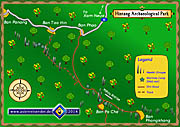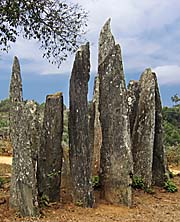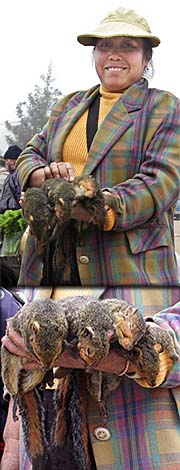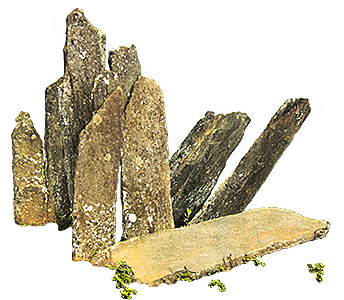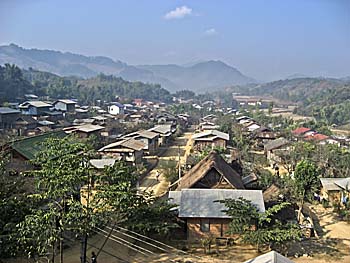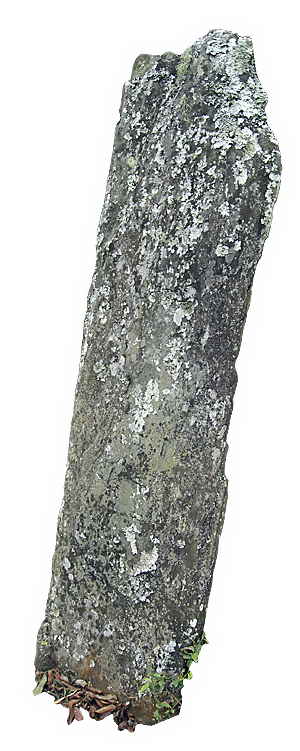1.
Hintang Archaeological Landscape
Another mysterious ancient site like the enigmatic Plain of Jars lies in the very east of north Laos: it's the megalithic menhirs of Hintang Archaeological Park. The park consists of 72 different sites in the jungle with alltogether around 1,500 menhirs - that's upright standing, long-shaped, pillar-like stones, hewn of schist. Additionally there are huge stone discs placed on the ground. The discs serve as closing lids for the entrances to underground chambers. It's supposed by archeologists that the site was an ancient burial place.

The menhirs of Hintang are certainly not the most spectacular thing one get's to see in his life. Nevertheless the site has it's charme. It's mysterious and far away from the beaten tourist track. Image by Asienreisender, 2006
Hintang Archeological Landscape's megalithic culture is dated back 2,000 to 3,000 years. That's roughly about the same age of the culture of the Plain of Jars, and there could have been a connection between both. However, it's very little explored by archeologists yet. That is partially so because the site is of smaller significance and less spectacular as other sites like Luang Prabang, Champasak or the Plain of Jars; besides it's suffering under contamination of unexploded ordnance (UXO, see also: 'Bombs on Laos').
Visiting the Hintang 'stone gardens' won't kick you into the orbit - it's nothing spectacular. You only see the menhirs in small groups standing in the nature. Access to the underground chambers is not possible.
There is also nothing done yet to preserve the sites. There is open access, no fence, no guard, no nothing to save them. The only hint to their historical meaning are a few signs with explanations (in English). The erosion process due to weather influences are obvious. The existing remains certainly look very different than they did in ancient times. The people who shaped them did that presumably with effort and care.
The intensive bombing by the US Air Force in the American Vietnam War also damaged the landscape heavily and partially the sites.
It can also be that locals or influencial Laotians take here and there a menhir away to put them elsewhere. That happens with the urns at the Plain of Jars at least.
Archeological Excavation
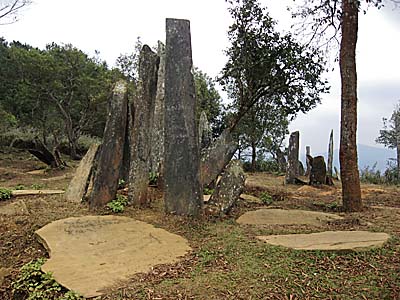
Another site with menhirs and some discs. The tallest menhir shows a graffiti (hardly to see on the small picture. It's written in English...). Image by Asienreisender, 2006
The stone gardens of Hintang were first researched in 1931 by an archaeological team led by Madeleine Colani (who did also the first researches on the Plain of Jars). Inside the burial chambers the archaeologists found very little: rough ceramic funeral urns, some stone objects for ceremonial use, some simple bronze bracelets... The findings are now in the Laotian National Museum in Vientiane. After the Colani expedition there was no further excavation done until today.
Since the menhirs mark the places so clearly, it's probable that tomb raiders found their way to them in the time the ancient culture wasn't anymore.
Tourism
The site of Hintang, by the locals rather known as 'Suan Hin Tang', the 'standing stone pillars', is all but a mass tourist destination. Very few visitors make their way into this remote area. It's situated some 60km away from Xam Neua in Hua Phan Province. There is little public transport. Going on a bus or songthaew on route no. 6 to Ban Phao, one has to walk another six kilometers on a lonesome dirt road to find the first bigger menhir groups. Some of the different sites are close to this road, others are spread over the area. Leaving the paths is risky, for the area is contamined with UXO.
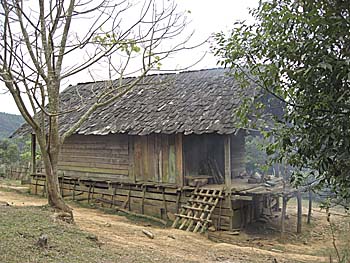
A typical peasant house on the way. The space below serves as a stable for livestock. Image by Asienreisender, 2006
The thrill in visiting the site is not only it's mystery but also the long walk through the lonesome mountainous and densly forested landscape. The villages are abandoned in daytime, the inhabitants are presumably out for work on the fields or wherever. Villages who look like they did in medieval times, without water supplies, drainage or electricity - simple wooden houses.
Though, the old times are over forever. Conspisuously was the 'silent forest syndrom' all around. No sound in the jungle, no animals were to see. Not even a single bird. Where have they gone? Well, the locals go hunting in the forests and they kill anything they get for food. There was not much living left anymore...
There is no accommodation at the site or the wider surroundings. Overnight is best possible in Xam Neua. To get a bus back to Xam Neua one has to wait a longer time. Several hours maybe. There is little traffic on route no. 6 - every 20 or so minutes a vehicle. If there is no bus coming anymore one has to sleep a night in a peasant's home on the floor and catch a bus next morning.
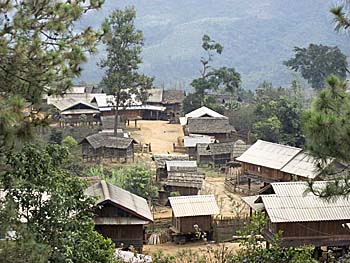
A remote hamlet in the mountains at Hintang Archaeological Park. Image by Asienreisender, 12/2006
Alternatively one can take it easy and hire a car inclusive driver for 50 US$ or so in Xam Neua.
When I was there in December 2006 in fact I didn't see any other foreigner in the three days being in and around Xam Neua. Meanwhile there might be a bit more tourism - the number of international arrivals in Laos is increasing every year. Besides the Laotian - Vietnamese border behind Xam Neua is presumably more frequented now than it was a few years before. In 2006 the border was infrequently open or closed, one could never know before. It was also said it were very difficult to get transport on the Vietnamese side... It can be that there is meanwhile much more traffic in and around Xam Neua. The motorbike and car industries make great business these days in Laos and fill the streets with vehicles.

Waiting for the bus at Ban Phao... will there be a bus? Image by Asienreisender, 12/2006
Map of Hintang Archaeological Park
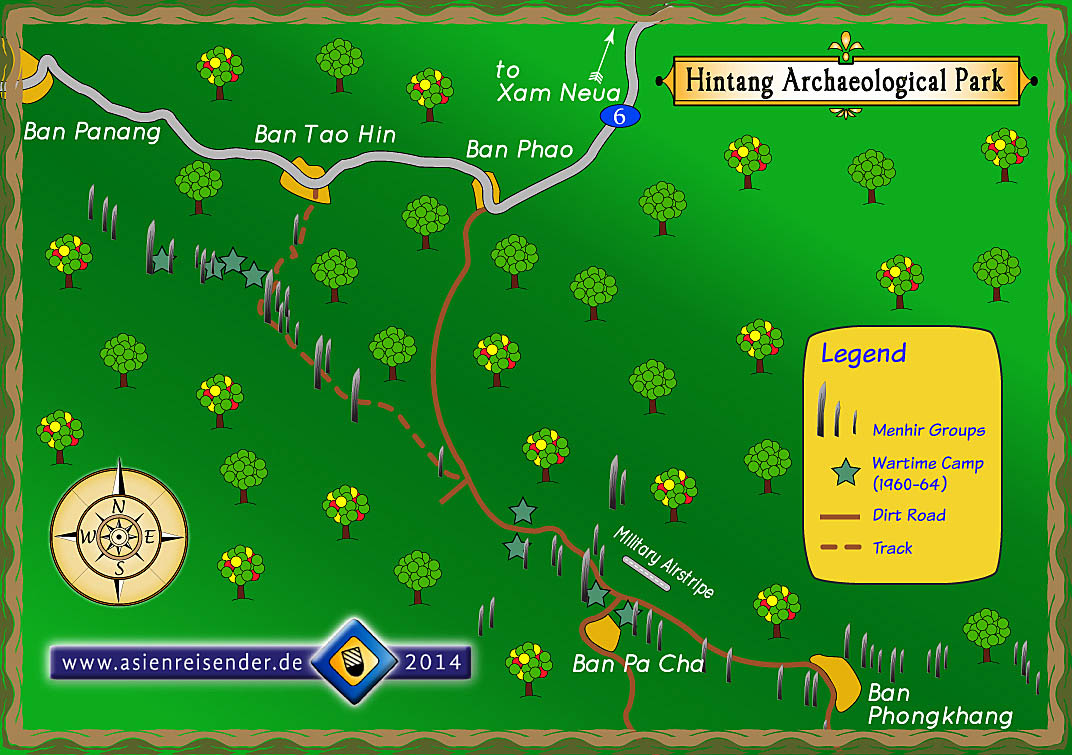
A map of the forested landscape of Hintang. Remarkable is the 'silent forest syndrome' - the forests were spookily silent.
